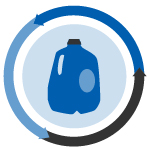 A fast-food giant reintroduces foam cups into its Chicago-area restaurants, and one company uses an anaerobic digestion process on end-of-life plastics.
A fast-food giant reintroduces foam cups into its Chicago-area restaurants, and one company uses an anaerobic digestion process on end-of-life plastics.
Container contention: The beverage industry is funding efforts to persuade Connecticut lawmakers against reviving expansions to the state’s container deposit law. The Associated Press writes that a coalition called “Keep CT Affordable,” backed by beverage giants, is opposing any handling fee increases, new beverage additions and a statewide excise tax on sugary drinks.
Cuts reversed: Funding for North Carolina’s state recycling support program has been largely preserved in a compromise budget approved by both legislative chambers last month. Resource Recycling, sister publication to Plastics Recycling Update, reports the division that runs the recycling program will be cut by $500,000, but that the recycling program is not directly impacted. North Carolina has a high concentration of plastics recycling companies.
Foam comeback: McDonald’s stores in Chicago are phasing foam polystyrene cups back into use after mostly removing them from restaurants in 2013. The Chicago Tribune writes the company has not explained why the foam cups are being used again, and that nonprofit advocacy organization As You Sow, which previously organized shareholder pressure to halt the use of foam cups, describes the move and its timing as curious.
Aquarium action: The Aquarium Conservation Partnership has announced a new effort to reduce the use of disposable plastic products at its facilities nationwide. According to The Baltimore Sun, member aquariums have already removed plastic straws and single-use bags from their on-site businesses, and they will ask visitors to consider using alternative, reusable materials. The campaign hopes to highlight the global ocean plastics problem.
Waste-to-energy partnership: Dow and Keep America Beautiful are working to expand a pilot program that diverts hard-to-recycle plastics using waste-to-energy processes. According to a press release, the organizations will fund two interested partners who want to start a program, through which households place pouches, food bags and plastic utensils in a special bag that goes into their curbside cart. The bags are separated at the materials recovery facility (MRF) and sent to energy-recovery facilities.
Informal players: As Chinese cities have grown and the country has seen increasing economic development and spending, the amount of waste generated has risen faster than domestic collection infrastructure can handle. In light of this trend, sustainability consultant Collective Responsibility provides a detailed look at the country’s informal recycling collection sector, which plays an important role in filling the infrastructure gap by collecting plastics and other materials.
Making plans: The Group of 20, an international forum of representatives from the world’s largest economies, has released an action plan aimed at tackling the marine litter problem. The plan says the group, made up of major rich and developing countries, will promote sustainable waste management through the U.S. EPA waste-management hierarchy, waste prevention, resource efficiency and more. The plan was praised by the World Plastics Council, an association made up of plastic manufacturers.
Digestible technology: An Australian company is developing technology that will use an anaerobic digestion process to convert end-of-life plastics into fertilizer and energy. The Lead South Australia reports the technology from POET Systems is looking to target plastics that would otherwise head for the landfill.


